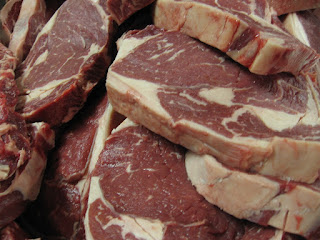What the hell are triglycerides and why should I concern myself with trying to lower them...? Not an easy question and one that is hard to answer without going to Mr. Roche's Science Class, or to Ms. Peles Diet Therapy Class...
Fats are a member of a class of compounds called lipids and within that group of compounds are triglycerides (along with sterols and phospholipids). When people say things like "that steak is pretty fatty" or "man, did you see how fat that chick was?" they are generally talking about triglycerides.
Fats have a series of chores within our bodies:
- They provide energy
- Insulate the body
- Protect vital organs
- Form the major material of cell membranes
Too little fat in our diet is just as much as a problem as too much fat, but being Westerners and gluttons, this is generally rarely an issue. Among the lipids, triglycerides are predominant, the name pretty much explains itself "tri" meaning three (fatty acids), and glyceride refers to glycerol (the backbone) that the fat clings to. So in order to make a triglyceride it needs three fatty acids and a backbone of glycerol.
In an effort t to simplify the meanings of fats to our health let’s just say that a triglyceride is the major form of fat in foods and the major storage form of fat in the body.
The major groups of fats that we hear about regularly are:
- Saturated fat
- Unsaturated fat
- Monounsaturated fat
- Polyunsaturated fat
- Trans-Fatty Acids
- Hydrogenated fat
- Omega-3 and Omega-6 Fatty Acids
I know that it is difficult to understand which one does what and even though we know that saturated fat is not good for our bodies, few of us really understand why. When analyzing or consulting a diet these are a few things that I generally advise:
Avoid Saturated and Trans-Fats as much as possible-
- Whole milk (even some reduced fat milks), cheese, butter, cream, cream cheese
- Fatty cuts of beef and pork, hot dogs, bacon, fatback
- Tropical Oils-palm, coconut, palm kernel and the products that contain them (cookies, cakes, donuts, pastries)
- Shortening and Lard
Utilize foods that contain Omega-3 and Omega-6 fatty acids
- Nuts and Seeds (butternuts, flaxseeds, walnuts, soybean kernels)
- Vegetable Oils (corn, canola, walnut, wheat germ, cottonseed, safflower, sesame, soybean, sunflower, liquid or soft margarine made from canola or soybean oil)
- Fatty Cold Water Fish (salmon, mackerel, anchovy, herring, lake trout, tuna, bluefish)
If watching your calories, attempt to keep your total fat intake under 30% of your total calories and concentrate on utilizing the poly and mono-unsaturated fats
Like I said earlier, some fats in our diets are beneficial, but too much fat, especially saturated and trans-fats along with cholesterol increase the risk of chronic diseases like High blood pressure and high cholesterol which in turn can lead to a variety of heart diseases.
Reduce Fat Intake and Choose Unsaturated Fats
One very good way is to reduce the amount of added fats that we put into our bodies (butter, mayonnaise, margarine, salad dressing, cream cheese, peanut butter etc.)
Choosing unsaturated fats is also a very good way of reducing fat intake, one thing that I tell my clients is the softer the fat is, the more unsaturated it is, generally speaking if you choose vegetable and fish oils (which are rich in polyunsaturated fat), olive and canola oil (rich in monounsaturated fat) and avoiding the harder fats (animal fats, lard and shortening, which are more than likely heavily saturated fats) you are more than likely going to reduce the amount of your total fat intake.
For a comprehensive list of foods that can aid in the lowering of blood cholesterol levels, ideas of cooking with less to no fat and samples of nutrient-dense low fat foods please visit:
http://www.nhlbi.nih.gov/guidelines/cholesterol/atp3full.pdf and view pages V-25-V-27



No comments:
Post a Comment